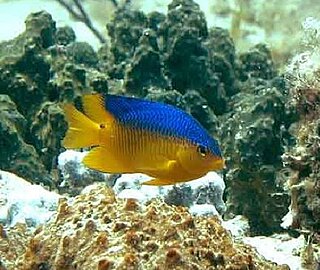
Pomacentridae is a family of ray-finned fish, comprising the damselfishes and clownfishes. This family were formerly placed in the order Perciformes but are now regarded as being incertae sedis in the subseries Ovalentaria in the clade Percomorpha. They are primarily marine, while a few species inhabit freshwater and brackish environments. They are noted for their hardy constitutions and territoriality. Many are brightly colored, so they are popular in aquaria.

Abudefduf, also known as the sergeant-majors, is a genus of fish in the family Pomacentridae.

Amblypomacentrus is a small genus of fish in the family Pomacentridae. As of the year 2000, there are 3 species.

Chromis is a genus of fish in the family Pomacentridae. While the term damselfish describes a group of marine fish including more than one genus, most damselfish are in the genus Chromis. These fish are popular aquarium pets due to their small size, tolerance for poor water quality, and bright colors, though their lifespans tend to be shorter than other fish.

Pomacentrus is a genus of marine damselfish in the family Pomacentridae. These fish inhabit tropical locations and are often captured or bred as aquarium fish.

Chrysiptera is a genus of damselfish in the family Pomacentridae.

The Indo-Pacific sergeant is a species of damselfish in the family Pomacentridae. It may also be known as the Sergeant major although this name is usually reserved for the closely related species Abudefduf saxatilis. The closely related Abudefduf caudobimaculatus was formerly considered to be synonymous with this species and, according to some authorities, is synonymous.

The nosestripe clownfish or nosestripe anemonefish, skunk clownfish, Amphiprion akallopisos, is an anemonefish that lives in association with sea anemones. A. akallopisos is found in the Indian Ocean. It resides in shallow inshore reefs as deep as 15 m with a moderate to strong current. The skunk clownfish can also be kept in captivity by aquarists.

Chromis chromis, the damselfish or Mediterranean chromis, is a small species of ray-finned fish of the family Pomacentridae from the Eastern Atlantic and Mediterranean.

The spiny chromis is a species of damselfish from the western Pacific. It is the only member of the genus Acanthochromis.
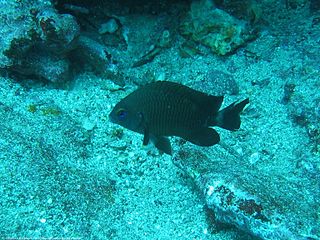
Stegastes beebei, is a species of damselfish found on coral and rocky reefs at depths between 0 and 15 m. They are somewhat territorial, and chase away small intruders. They are omnivorous, grazing on algae and nibbling at small crustaceans and the tentacles of anemones. They are oviparous, with distinct pairing during breeding. The eggs are demersal and adhere to the substrate. Males guard and aerate the eggs.

Amblyglyphidodon curacao; also known as the staghorn damselfish , the clouded damselfish or the bare-snouted sergeant major; is a species of marine fish in the family Pomacentridae, the damselfishes and the clownfishes. It's widespread throughout the tropical waters of the western Pacific Ocean. This species is a small sized fish that can reach a maximum size of 11 cm length.
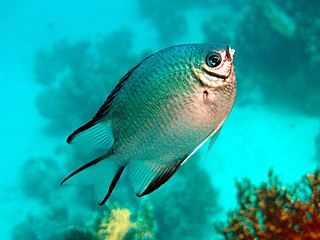
Amblyglyphidodon leucogaster also known as the yellowbelly damselfish is a species of marine fish in the family Pomacentridae, the damselfishes and clownfishes. It's widespread throughout the tropical waters of the Indo-West Pacific, Red Sea included. It's a small size fish that can reach a maximum size of 13 cm length.
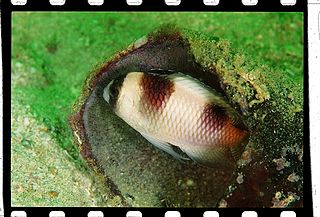
Amblypomacentrus breviceps, known commonly as the black-banded demoiselle , is a species of marine fish in the family Pomacentridae, the damselfishes and the clownfishes.
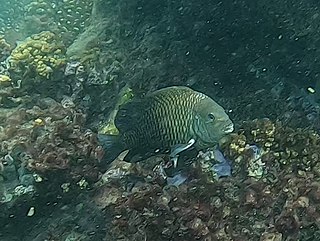
Stegastes acapulcoensis, commonly called the Acapulco major, the Acapulco damselfish, or the Acapulco gregory, is a species of damselfish of the family Pomacentridae. It is native to the eastern Pacific Ocean.

Abudefduf troschelii, the Pacific sergeant major or Panama sergeant major, is a species of damselfish belonging to the family Pomacentridae that can be identified by the pronounced black stripes on the lateral sides of the fish. Its specific name honors the zoologist Franz Hermann Troschel (1810-1882). It is native to the neritic pelagic zone of the shallow water coral reefs in the Eastern Pacific Ocean and they are an omnivorous species feeding on plankton and algae attached to their coral habitat. Abudefduf troschelii is a sister-species of A. saxatilis but have diverged from each other since the uplift of the isthmus of Panama, separated by the rise of the Panama land bridge 3.1 to 3.5 million years ago. Males, like in many other marine species, take care of and defend newborn A. troschelii after they have been hatched by eggs from the female. There are currently no major threats to the species and there is no indication of a current decline in its population size. The IUCN Red List lists this damselfish as being of “least concern”.
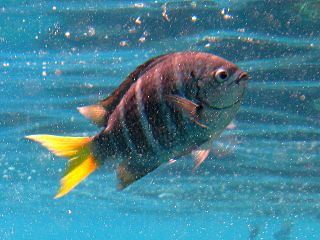
The yellowtail sergeant is a species of damselfish in the family Pomacentridae native to the Indo-Pacific. It can grow to a maximum total length of 17 centimetres (6.7 in).
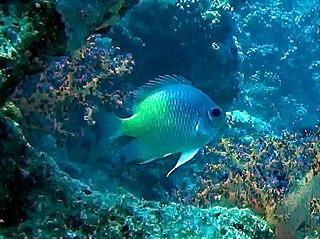
Amblyglyphidodon flavilatus, known as yellow damselfish, yellowfin damselfish, yellow flank damselfish, yellow side damselfish, and yellow-sided Damselfish, is part Pomacentridae, which is a family of ray-finned fish including damselfish and clownfish. This family represents the greatest diversity and abundance of fish species inhabiting coral reefs. They were first discovered in the 1980s by Allen and Randall.
Amblypomacentrus vietnamicus is a species of ray-finned fish from the family Pomacentridae, the damselfishes and clownfishes. It was described in 2004 from the South China Sea off Vietnam, It differs from its congeners in lacking the dark bars seen in Amblypomacentrus breviceps and A. clarus.
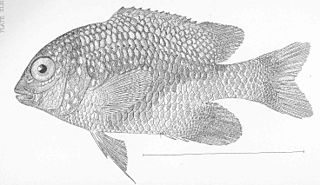
Microspathodon bairdii, the bumphead damselfish, is a species of ray-finned fish from the family Pomacentridae. It is found in the eastern Pacific Ocean.


















